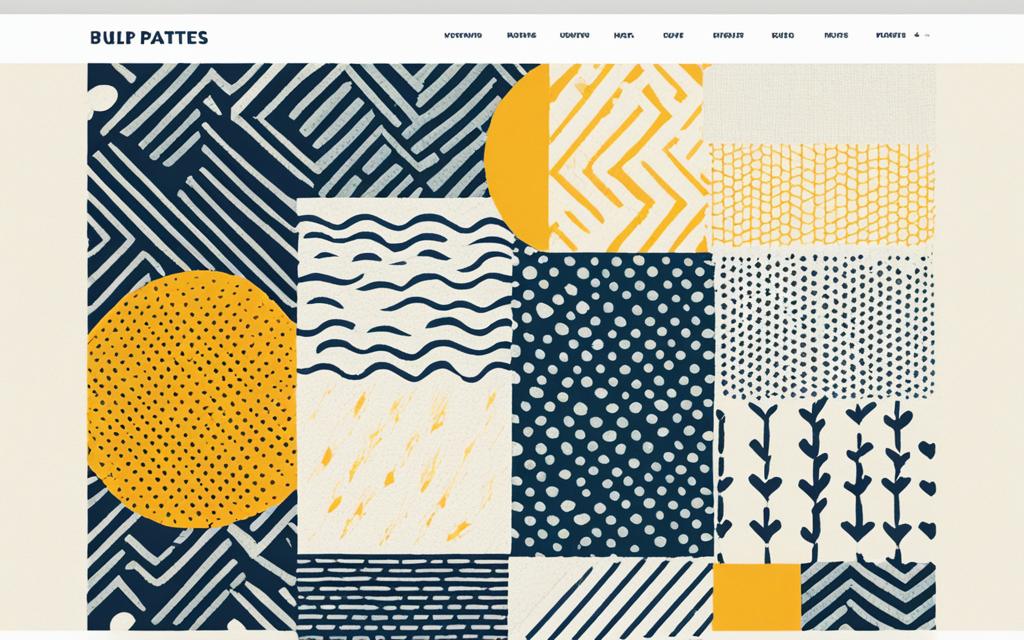Table of Contents
In the world of web design, textures and patterns play a pivotal role in creating visually stunning and engaging websites. From adding depth and realism to enhancing user engagement, textures and patterns have become powerful tools for web designers. In this article, we will explore the creative use of textures and patterns in web design, discussing their significance in terms of user engagement and site aesthetics.
Whether it’s incorporating subtle textures or bold patterns, these design elements can make a significant impact on the overall aesthetics of a website. They provide a visual richness and uniqueness that captures users’ attention and creates a memorable experience. Moreover, textures and patterns can help establish a brand identity and evoke specific emotions or associations.
By carefully selecting and skillfully applying textures and patterns, designers have the ability to transform a website from ordinary to extraordinary. With their creativity and attention to detail, they can create visually stunning designs that engage users and leave a lasting impression.
In the following sections, we will showcase examples of web designs that effectively use textures and patterns, discuss the importance of these design elements, provide tips for incorporating them into web design projects, and share resources and tools to help designers find and create textures and patterns.
Join us on this journey through the world of creative textures and patterns in web design, and discover how you can enhance your own designs with these powerful elements.
Examples of Web Designs Using Textures and Patterns
In this section, we will showcase 20 excellent examples of web designs that effectively use textures and patterns. These examples range from corporate to creative websites, showcasing the versatility and impact of textures and patterns in web design.
Web designers understand the power of visual elements when it comes to capturing the attention of users and creating an engaging online experience. The creative use of textures and patterns can elevate a website’s aesthetics and provide a unique visual appeal.
By incorporating textures and patterns strategically, web designers can add depth, texture, and visual interest to their designs. Whether it’s a subtle background pattern, a bold textured element, or a combination of both, these design choices can greatly enhance the overall user experience.
The examples we have selected demonstrate how textures and patterns can be applied in various styles and industries. From sleek and modern corporate websites to artistic and whimsical portfolios, the possibilities are limitless when it comes to using textures and patterns to create visually stunning web designs.
Here are just a few noteworthy examples:
- A financial services website utilizes a subtle geometric pattern in its background, evoking a sense of stability and professionalism.
- An e-commerce platform incorporates a textured product showcase, enhancing the tactile nature of the shopping experience.
- A photography portfolio showcases stunning images against a backdrop of a textured canvas, mimicking the look and feel of a physical gallery.
These examples demonstrate how textures and patterns can be used to effectively communicate brand personality, evoke certain emotions, and create a cohesive visual experience.
Now, let’s take a closer look at some of these inspiring web designs:
Corporate Website Example: Company X
Description: Company X’s website showcases a clean and modern design, incorporating subtle gradients and patterns to add visual interest.
Creative Agency Portfolio Example: Studio Y
Description: Studio Y’s portfolio website features bold and vibrant patterns, reflecting their artistic approach and unique brand identity.
E-commerce Website Example: Store Z
Description: Store Z’s e-commerce website incorporates textured backgrounds and patterns to create an immersive and visually captivating shopping experience.
These examples provide a glimpse into the wide range of textures and patterns that can be used in web design. From subtle accents to bold statements, textures and patterns are powerful design elements that can elevate the aesthetics and user experience of a website.
Next, we’ll explore the importance of textures and patterns in web design and how they contribute to the overall success of a website.
Importance of Textures and Patterns in Web Design
Textures and patterns play a crucial role in web design. They are not only visually appealing but also contribute to creating a more engaging and immersive user experience. By adding depth and visual interest, textures and patterns enhance the overall aesthetics of a website, encouraging users to explore and interact with the content.
One of the key benefits of using textures and patterns in web design is their ability to establish a brand identity. By incorporating unique textures and patterns that align with the brand’s values and personality, designers can create a consistent and memorable visual language. This helps to differentiate the website from competitors and reinforces the brand’s positioning in the minds of users.
Furthermore, textures and patterns contribute to creating a unique user experience. They can evoke certain emotions and associations, setting the tone for the overall website experience. For example, a website featuring a wood grain texture and organic patterns may create a sense of warmth and nature, while a website with sleek metallic textures and geometric patterns may convey a modern and futuristic feel.
Incorporating textures and patterns effectively can greatly improve user engagement. They help to break up visual monotony, providing visual cues and points of interest that guide users through the content. By strategically placing textures and patterns, designers can direct the users’ attention to important elements and create a seamless flow of information.
Increased User Retention and Conversion
Research has shown that well-designed websites with appealing textures and patterns have a higher probability of retaining users and increasing conversion rates. When users are visually stimulated and engaged, they are more likely to stay on the website for longer periods, explore different sections, and take desired actions such as making a purchase or submitting a form.
Moreover, textures and patterns contribute to a website’s overall credibility and professionalism. Thoughtful and meaningful use of textures and patterns conveys attention to detail and a high level of craftsmanship, which can positively impact users’ perception of the website and the brand it represents.
“Textures and patterns in web design add that special touch of creativity and personality. They can turn a regular website into a visually stunning and memorable experience for users.” – Sarah Johnson, Senior Web Designer
In conclusion, the use of textures and patterns in web design is of utmost importance. They contribute to the overall aesthetics, user engagement, brand identity, and user experience of a website. By incorporating textures and patterns effectively, designers can create visually captivating websites that leave a lasting impression on users.
Tips for Using Textures and Patterns in Web Design
When incorporating textures and patterns into your web design, it’s essential to consider a few key tips to ensure a visually appealing and user-friendly website. By following these guidelines, you can effectively utilize textures and patterns to enhance your web design:
- Choose Complementary Textures and Patterns: Select textures and patterns that align with the overall design and content of your website. These elements should harmonize with the site’s theme and purpose, enhancing the user experience.
- Maintain a Balance: Striking the right balance is crucial. While textures and patterns can add depth and visual interest, it’s important not to overwhelm the design. Ensure that the use of textures and patterns doesn’t overshadow essential content or compromise the clarity of the interface.
- Consider Performance: Keep in mind that textures and patterns can impact website performance and loading speed. Optimize your assets to minimize any negative effects on user experience. Compress images and utilize CSS techniques to reduce file sizes and optimize loading times.
By following these tips, you can harness the power of textures and patterns to create visually striking web designs that engage users and deliver an exceptional browsing experience.
Remember, textures and patterns should enhance your web design, not overpower it. A well-balanced and carefully curated selection of textures and patterns can elevate your website aesthetics and draw users in.
Resources for Finding Textures and Patterns
Finding the right textures and patterns for a web design project can be a challenge. Luckily, there are many online resources available that offer a wide range of high-quality textures and patterns. In this section, we will provide a list of websites where designers can find free and premium textures and patterns to enhance their web designs.
Here are some top resources for finding textures and patterns:
- Textures.com – This website offers a vast collection of free and premium textures, including seamless patterns, high-resolution images, and 3D textures. Designers can browse through various categories and even customize the size and format of their desired textures.
- Freepik – Freepik is a popular platform that provides free graphic resources, including textures and patterns. Designers can choose from a wide range of options and download the resources in different formats such as PNG, PSD, and SVG.
- Subtle Patterns – If you’re looking for subtle and seamless patterns, Subtle Patterns is the go-to website. It offers a collection of elegant and minimalistic patterns that can add a sophisticated touch to your web designs. All the patterns are available for free download.
- Pixeden – Pixeden provides a variety of design resources, including textures and patterns. They offer both free and premium options, catering to different design needs. Explore their extensive collection to find the perfect textures and patterns for your projects.
Remember to check the licensing and terms of use for each resource before incorporating the textures and patterns into your web designs. By utilizing these resources, designers can access a plethora of options to enhance the visual appeal and aesthetics of their websites.
Tools for Creating Textures and Patterns
In addition to finding pre-made textures and patterns, designers can also create their own. There are several tools and software available that allow designers to unleash their creativity and craft custom textures and patterns for their web designs. These powerful tools provide the flexibility to experiment and create unique visual elements that align with the design vision.
Here are some recommended tools for designers looking to create their own personalized textures and patterns:
- Adobe Photoshop: Adobe Photoshop is a widely-used graphics editing software that offers robust features for creating textures and patterns. Designers can leverage its versatile tools, such as brushes, filters, and blending modes, to achieve stunning effects and manipulate images to their desired look.
- Sketch: Sketch is a popular design tool that offers an intuitive interface and powerful functionality. With its extensive library of plugins and customizable vector editing features, designers can create intricate patterns and textures with ease.
- Procreate: Procreate is a digital painting app specifically designed for iPad. It provides a wide range of brushes and effects that allow designers to paint and create detailed textures and patterns directly on their tablet.
- Substance Designer: Substance Designer is a powerful node-based texturing tool for creating complex and realistic materials. It offers a non-destructive workflow and procedural approach, enabling designers to experiment and iterate quickly.
- Inkscape: Inkscape is a free and open-source vector graphics editor that allows designers to create high-quality textures and patterns. Its extensive set of tools and filters provide the flexibility needed to produce intricate designs.
By utilizing these tools, designers can elevate their web designs with custom textures and patterns that truly stand out. The ability to create unique visual elements adds a touch of originality and contributes to a memorable user experience.
Creating Custom Textures and Patterns in Adobe Photoshop
One of the most widely used software for creating textures and patterns is Adobe Photoshop. With its extensive toolset and capabilities, designers can unleash their creativity and design unique visual elements for their web projects.
Adobe Photoshop is a versatile tool that empowers designers to craft intricate and captivating textures and patterns. By enabling layer blending modes, utilizing filters, and employing brush techniques, designers can achieve stunning effects and transform simple shapes into visually compelling designs.
Here’s a step-by-step guide on how to create custom textures and patterns in Adobe Photoshop:
- Open Adobe Photoshop and create a new document with the desired dimensions.
- Choose the shape or object you want to apply the texture or pattern to.
- Create a new layer and select the desired color or gradient for the texture/pattern.
- Apply filters or blending modes to the layer to achieve the desired effect.
- Experiment with various brushes and brush settings to add details and depth.
- Adjust the opacity and blending options to fine-tune the texture or pattern.
- Save the texture or pattern as a separate file for future use.
Remember to explore different techniques, experiment with layer styles, and combine various elements to create truly unique textures and patterns that elevate your web designs.
Once the custom textures and patterns are created, they can be seamlessly integrated into web design projects to add visual interest and enhance the overall user experience. The possibilities are endless when designers have the tools and creativity to craft their own textures and patterns.
Conclusion
Textures and patterns are essential elements in web design, offering endless creative possibilities for designers. When utilized effectively, they have the power to transform the aesthetics of a website, captivate users, and deliver an exceptional user experience.
Throughout this article, we have explored the importance of textures and patterns in web design. By incorporating them thoughtfully, designers can add depth, visual interest, and authenticity to their creations, resulting in visually stunning and engaging websites.
By following the tips provided and utilizing the wide range of resources and tools available, designers can easily integrate textures and patterns into their web designs. Whether it’s finding the perfect texture or pattern online or creating custom ones, they have the means to create unique and captivating visual experiences for their audience.
As the web design industry continues to evolve, textures and patterns remain timeless assets that contribute to the success of a website. By placing emphasis on their usage, designers can achieve outstanding results, enhancing the overall visual appeal and user engagement of their web designs.
FAQ
How do textures and patterns enhance web design?
Textures and patterns add strength and realism to web design, elevating user engagement and enhancing the overall aesthetics of a website.
What role do textures and patterns play in web design?
Textures and patterns play a crucial role in web design by adding depth and visual interest to a website, making it more engaging for users. They can also help establish a brand identity and create a unique user experience.
What are some tips for using textures and patterns in web design?
When using textures and patterns in web design, it’s important to choose ones that complement the overall design and content of the website. Striking a balance between using textures and patterns and maintaining a clean and user-friendly interface is crucial. Designers should also consider the impact on website performance and loading speed.
Where can designers find textures and patterns for web design?
There are many online resources available that offer a wide range of free and premium textures and patterns for designers to enhance their web designs.
Can designers create their own textures and patterns for web design?
Yes, designers can create their own textures and patterns using various tools and software available in the market.













